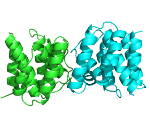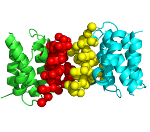PPCheck is a webserver that can be used to measure the strength of interactions between any two given proteins/chains, provided their coordinates are available in a single PDB file. The interactions are measured using standard energy calculations involving non-bonded interactions like van der Waals, electrostatic and hydrogen bonds. The sum of these interactions is expressed as psuedoenergy, whose ranges have been standardized using known sets of protein-protein complexes. All the residues which individually participate in any of these interactions are considered to be present at the interface and are listed. The "Total stabilizing energy" contributed by all the non-bonded interactions is divided by the total number of "interface residues" to obtain "normalized energy per residue". We observed that, in general, the "normalized energy per residue" for a stable interaction ranges from -2 kJ/mol to -6 kJ/mol and this can be used to validate protein-protein interactions and a correct docking pose. (Anshul and Sowdhamini, Molecular Biosystems, 2013)
PPCheck can also be used to predict the energetically important residues present at the interface known as "Hotspots". PPCheck was applied on a training dataset containing non-redundant protein-protein interfaces from Alanine Scanning Energetics Database (ASEdb) and a separate test dataset from Binding Interface Database (BID) and it was observed that PPCheck could successfully predict hotspots with an accuracy of ~70%.
Separately, PPCheck was applied on a set of 1883 decoys submitted as "Best Predictions" from CAPRI predictors for the 6 targets T24, T25, T26, T29, T32 and T36 and it was observed that PPCheck could successfully discard ~50% of the incorrect predictions and report ~ 66% of the correct predictions.
Thus, PPCheck is the only server, to the best of our knowledge, which can be useful for many purposes i.e. it can calculate strength of protein-protein interactions, predict hotspots and correct docking pose efficiently.
Features
H-bond fixing and H-bond energy calculations
Before calculating hydrogen bonds, PPCheck fixes the hydrogen atoms for all the amino acids present in the proteins. The positions of hydrogens with respect to the connecting atoms have been determined/fixed geometrically using standard bond lengths, angles and torsion angles for all types of atoms; methyl, methylene, tertiary groups; considering sp3, sp2, and sp atomic states of hybridization as described in the paper (M. Nardelli.,1982). The hydrogen bond energies for a given system is calculated using the Kabsch & Sander's equation as given in the DSSP paper (Kabsch et at 1983). Refer methodology page for details on H-bond energy equation.
Electrostatic energy calculations
The electrostatic interaction energy of the system is calculated using Coulomb's equation. Instead of a constant dielectric we use the distance dependent dielectric (DDD) constant in the calculation of electrostatic energies. The current usage of DDD constant (2*D i.e. twice the distance between the atoms) would yeild an appropriate energy value depending upon the effect of interaction between the residues involved. Refer methodology page for details on the electrostatic energy equations and the various parameters been used.
van der Waals energy calculations
The van der Waals energy component includes the hydrophobic interactions and the energy contributed by the van der Waals pairs. Here we fix the hydrogens to the given system and then use the H-fixed structure for the calculation of energy. Refer methodology page for details on the calculation of van der waals energy.
Total Stabilizing Energy
It is the summation of energies contributed by all the above mentioned non-bonded interactions.
Interface Residues
All those residues which contribute to any of the non-bonded interactions as mentioned above are treated as interface residues.
Normalized Energy per residue and Standardization
PPCheck calculates both the pseudoenergy and the number of interface residues. It also calculates the normalized energy per residue (ratio of total stabilizing energy and total number of interface residues). Normalized energy per residue values have been standardized using the established set of protein-protein interacting complexes and it has been observed that the stabilizing protein-protein complexes have its value in the range -2 kJ/mol to -6 kJ/mol. (Anshul and Sowdhamini, Molecular Biosystems, 2013)
This energy range can be used for validating new protein-protein interactions or in other words can be used to predict the correct docking pose.
Short Contacts
All those atoms which come closer to a distance which is sum of their van der Waals distance - (minus) 0.40Å are considered to form a short contact. PPCheck reports all these short contacts in a separate list.
Hydrophobic Interactions
All the hydrophobic residues like ALA, LEU, ILE, VAL, TRP, TYR and PHE are reported to form hydrophobic interactions if their CB-CB atom distance is less than 7Å.
Salt Bridges
All the charged residues like ASP, GLU, HIS, ARG and LYS are reported to form salt bridges if the side-chain nitrogen and oxygen atoms of two oppositely charged residues are observed closer than 4Å.
Protein Hotspots
Hotspot residues are the ones which are energetically more important than the rest of the residues at the interface. They are generally more conserved and have the tendency to occur in cluster. PPCheck can predict these hotspots with an accuracy of ~70%.
Correct Docking Pose
Molecular docking generates large number of complexes with individual proteins having different conformations and the two protein bound to one another at same/different binding sites. Prediction of correct docking pose with high accuracy is still a challenging problem. PPCheck, however, can predict reliably the correct docking pose by checking if the normalized energy per residue falls within a standard energy range of -2kJ/mol to -6kJ/mol which was obtained by studying a large number of well characterized protein-protein complexes.
|

